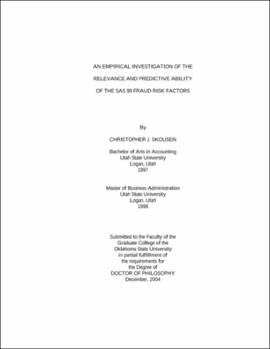| dc.contributor.advisor | Wright, Charlotte J. | |
| dc.contributor.author | Skousen, Christopher J. | |
| dc.date.accessioned | 2013-11-26T08:31:17Z | |
| dc.date.available | 2013-11-26T08:31:17Z | |
| dc.date.issued | 2004-12 | |
| dc.identifier.uri | https://hdl.handle.net/11244/7144 | |
| dc.description.abstract | Scope and Methodology: This study empirically examined the fraud risk factors adopted by the Accounting Standards Board in SAS No. 99 and developed a fraud prediction model that is useful in discriminating between fraud and no-fraud firms. The first phase of testing involved identifying and testing proxies for Cressey's fraud triangle (pressure, opportunity, and rationalization). A step-wise logistic regression analysis of matched sample firms was used to evaluate the usefulness of the fraud risk factors in discriminating between fraud and no-fraud firms. Notably, all data was collected from publicly available sources. | |
| dc.description.abstract | Findings and Conclusions: After identifying the significant fraud risk factors, the study applied multiple discriminate analysis to the significant variables to develop a fraud prediction model. The results indicate that users of publicly available data should take additional precautions when companies have audit committees with a low percentage of outside directors, high management ownership exceeding 5%, high cumulative percentage ownership in the firm held by insiders, and/or a CEO who holds both the CEO and Chairman of the Board position. | |
| dc.description.abstract | The prediction model correctly classified fraud firms 72% of the time. This finding is important since Kuruppu et al. (2003) noted that the Altman bankruptcy model, when applied to matched samples such as this study, only has an accuracy rate of between 40 and 50%. Additionally, studies that have expanded the financial ratios used by Altman (1969), such as Persons (1995) and Kaminski et al. (2004), have correctly identified fraud firms in the year prior to the fraud only 20 to 40% of the time. The fraud prediction model developed in this study is more accurate in correctly identifying no-fraud firms. The overall effect is that this fraud prediction model has a lower misclassification error of fraud and no-fraud firms than the other models. | |
| dc.format | application/pdf | |
| dc.language | en_US | |
| dc.rights | Copyright is held by the author who has granted the Oklahoma State University Library the non-exclusive right to share this material in its institutional repository. Contact Digital Library Services at lib-dls@okstate.edu or 405-744-9161 for the permission policy on the use, reproduction or distribution of this material. | |
| dc.title | Empirical investigation of the relevance and predictive ability of the SAS 99 fraud risk factors | |
| dc.contributor.committeeMember | Hansen, Don R. | |
| dc.contributor.committeeMember | Johnson, Carol Bauman | |
| dc.contributor.committeeMember | Tilley, Daniel S. | |
| osu.filename | Skousen_okstate_0664D_1115.pdf | |
| osu.accesstype | Open Access | |
| dc.type.genre | Dissertation | |
| dc.type.material | Text | |
| dc.subject.keywords | sas no. 99 | |
| dc.subject.keywords | fraud | |
| dc.subject.keywords | risk | |
| thesis.degree.discipline | Business Administration | |
| thesis.degree.grantor | Oklahoma State University | |
